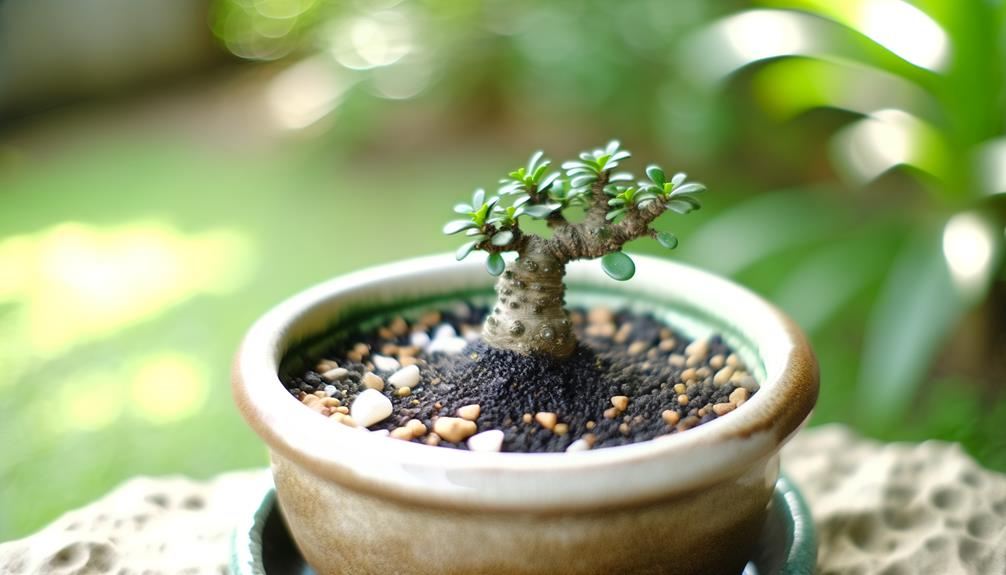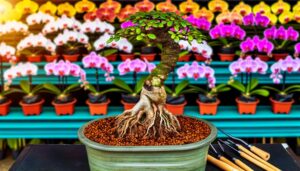How to Use Cactus Soil for Bonsai – A Step-by-Step Guide
Yes, you can use cactus soil for bonsai, but with modifications. Both cactus and bonsai soils emphasize excellent drainage, yet bonsai soil includes akadama, pumice, and lava rock for balanced moisture retention and root health.
Cactus soil is typically inorganic and may lack essential nutrients for bonsai. To optimize cactus soil for bonsai, amend it with organic matter and controlled-release fertilizers.
Adjust pH and nutrient levels regularly to support healthy root growth. Structurally, enhancing the soil with bonsai-specific components like akadama will ensure best results.
For detailed guidance on enriching cactus soil to suit bonsai, consider exploring further.

Key Takeaways
- Cactus soil can be used for bonsai but may require amendments for essential nutrients.
- Adding organic matter to cactus soil improves water retention and nutrient provision for bonsai.
- Incorporate inorganic aggregates like akadama, pumice, or lava rock to enhance drainage and aeration.
- Regularly monitor and adjust the soil's pH and nutrient content for optimal bonsai health.
- Cactus soil's excellent drainage properties help prevent root rot in bonsai.
Understanding Cactus Soil

Cactus soil, characterized by its outstanding drainage properties and low natural content, is specifically formulated to mimic the arid conditions in which cacti naturally thrive. This specialized soil typically comprises a mix of inorganic materials such as sand, perlite, pumice, and gravel, which facilitate rapid water runoff and aeration, critical for preventing root rot.
The minimal organic matter guarantees that the soil remains less compact, reducing water retention and promoting a healthier root environment. Additionally, the soil's pH is often slightly acidic to neutral, aligning with the natural habitat of most cacti.
Understanding these attributes is crucial for horticulturists and gardeners aiming to replicate desert-like conditions, ensuring the best growth and health of cacti and other succulents.
Characteristics of Bonsai Soil
To cultivate a flourishing bonsai, the soil must be carefully formulated to provide excellent drainage, adequate aeration, and the right balance of nutrients, reflecting the intricate needs of these miniature trees.
Bonsai soil typically consists of a blend of inorganic components such as akadama, pumice, and lava rock, which guarantee proper water retention and root development. Organic matter, often in the form of composted bark, is included to supply essential nutrients.
The soil's structure is pivotal; it must prevent waterlogging while allowing sufficient oxygen to permeate the root zone. Additionally, the pH level should be slightly acidic to neutral, aligning with most bonsai species' preferences.
This specialized composition supports the delicate balance required for bonsai health and strength.
Comparing Soil Properties

Evaluating the distinct properties of cactus soil versus traditional bonsai soil reveals significant differences in composition, drainage capabilities, and nutrient profiles.
Cactus soil typically comprises a mix of sand, perlite, and organic material, designed to guarantee rapid drainage and minimal water retention. This composition benefits succulents by preventing root rot but may not suit bonsai trees, which require consistent moisture levels.
Conversely, bonsai soil often includes akadama, pumice, and lava rock, providing a balance of aeration and moisture retention critical for the delicate root systems of bonsai.
Nutrient-wise, bonsai soil is formulated to supply essential minerals gradually, whereas cactus soil may not meet the specific nutrient demands of bonsai species, potentially leading to growth deficiencies.
Water Retention Needs
Understanding the water retention needs of bonsai trees is crucial for selecting an appropriate soil mix that supports their delicate root systems and overall growth.
Bonsai trees require a balance between adequate moisture and proper drainage to prevent root rot and promote healthy development. Unlike cacti, which thrive in arid environments with minimal water, bonsai trees need a substrate that retains moisture without becoming waterlogged.
Cactus soil typically contains coarse sand, perlite, and other fast-draining materials, which may not provide sufficient water retention for most bonsai species. To achieve ideal water retention, a bonsai soil mix should include components like akadama, pumice, and organic matter, ensuring a balanced moisture environment that enhances root health and tree strength.
Nutrient Requirements

When considering nutrient requirements for bonsai trees, one must account for the essential soil nutrients integral to their growth. These include nitrogen, phosphorus, and potassium.
In the context of cactus soil, which typically has lower nutrient content, supplemental fertilization becomes a critical practice.
Determining the suitable fertilization frequency guarantees that the bonsai receives a balanced supply of nutrients tailored to its specific developmental stages.
Essential Soil Nutrients
To cultivate healthy bonsai, it is important to make certain that the soil provides a sufficient balance of essential nutrients, including nitrogen, phosphorus, and potassium, as well as trace elements such as iron, manganese, and zinc. Nitrogen supports vigorous leaf and stem growth, phosphorus is crucial for root development and flowering, while potassium enhances overall plant health and disease resistance.
Trace elements, although needed in smaller quantities, play crucial roles in photosynthesis, enzyme activation, and chlorophyll formation. A bonsai medium must be meticulously formulated to ensure these nutrients are readily available, facilitating optimal growth and resilience.
Regular monitoring and soil testing can help maintain this delicate balance, ensuring the bonsai's long-term vitality and aesthetic appeal.
Fertilization Frequency
Regular fertilization is necessary to sustain the nutrient balance in bonsai soil, maintaining the continuous availability of essential elements for optimal plant health and growth. Due to the limited soil volume, bonsai trees quickly deplete available nutrients. As a result, a structured fertilization regimen is crucial.
Consider the following guidelines:
- Seasonal Adjustments: Use a high-nitrogen fertilizer in spring, balanced fertilizers in summer, and low-nitrogen formulations in autumn to support different growth phases.
- Application Frequency: Fertilize every two weeks during the growing season, tapering off in late summer. Reduce frequency significantly in winter when growth is minimal.
- Specific Nutrient Needs: Include micronutrients like iron, manganese, and zinc, which are essential for photosynthesis and overall plant vitality.
Following these practices will optimize bonsai health.
Root Health Considerations
Ensuring root health in bonsai requires meticulous attention to proper drainage and nutrient availability. Cactus soil, with its excellent drainage properties, helps prevent root rot by allowing excess water to escape easily.
Additionally, understanding the nutrient composition and retention capabilities of cactus soil is essential for maintaining the delicate balance necessary for bonsai vitality.
Proper Drainage Importance
Understanding the crucial role of proper drainage in maintaining ideal root health is necessary for successfully cultivating bonsai trees. Effective drainage helps reduce the risk of waterlogging, which can lead to root rot and other harmful conditions. Proper drainage guarantees that excess water exits the soil medium promptly, thereby maintaining an excellent balance of moisture and aeration. This balance is vital for root respiration and nutrient uptake.
Consider the following key points:
- Water Flow: Ensuring water passes through the soil without pooling helps prevent fungal infections.
- Aeration: Well-draining soil promotes oxygen availability to the roots, facilitating healthy growth.
- Soil Composition: Incorporating inorganic materials like pumice or perlite enhances drainage capabilities.
These factors collectively contribute to robust root health, foundational for thriving bonsai.
Nutrient Availability Factors
For best root health in bonsai cultivation, nutrient availability hinges on factors such as soil composition, pH levels, and the presence of essential macro and micronutrients.
Cactus soil typically offers good drainage, but its nutrient profile may differ significantly from bonsai-specific substrates. Essential nutrients like nitrogen, phosphorus, and potassium must be balanced, while trace elements such as iron, manganese, and zinc are important for optimal root function.
The pH level influences nutrient uptake, with bonsai trees generally thriving in slightly acidic to neutral conditions (pH 6.0-7.0). Thus, while cactus soil can be modified with organic matter and controlled-release fertilizers, careful monitoring of nutrient content and pH is important to ensure the holistic health of bonsai roots.
Practical Soil Mix Tips

A well-balanced bonsai soil mix typically incorporates a combination of inorganic and organic components to guarantee proper drainage, aeration, and nutrient retention.
To craft an effective soil mix for bonsai, consider these essential elements:
- Inorganic Aggregates: Utilize materials like akadama, pumice, and lava rock. These components ensure ideal drainage and prevent root rot by promoting air circulation.
- Organic Matter: Include components such as composted pine bark or leaf mold to improve water retention and provide necessary nutrients for the bonsai.
- Particle Size: Aim for uniform particle sizes to maintain a consistent balance between drainage and moisture retention. Avoid overly fine particles, as they can compact and impede root growth.
Conclusion
To sum up, while cactus soil and bonsai soil share some similarities, they ultimately cater to different horticultural needs. Cactus soil, like a minimalist canvas, lacks the diverse nutrient profile and tailored water retention properties essential for the intricate art of bonsai cultivation.
For best bonsai health, a specialized soil mix that balances aeration, moisture retention, and nutrient availability is essential. Therefore, using cactus soil for bonsai is not recommended for achieving the meticulous balance required.






